Buildings 2.0
Buildings 2.0 dives deep into the technology, trends and talent reshaping the structures where we live and work. Hosted by Jose Cruz Jr, this podcast brings you interviews with the industry’s brightest minds, from visionary architects and property owners to chief innovation officers. Brought to you by Integrated-Projects.com.
Episodes
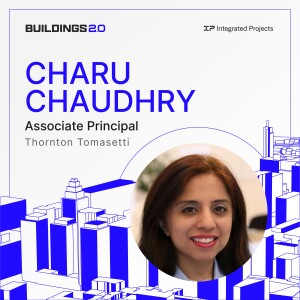
Thursday Aug 08, 2024
Thursday Aug 08, 2024
In this episode of Buildings 2.0, Jose speaks with Charu Chaudhry, Associate Principal at Thornton Tomasetti, to explore the fascinating world of historical building preservation. Charu shares her journey from working on 10th century Buddhist monasteries in India to tackling 18th century rowhouses.
Charu offers her insights into balancing historical preservation with modern needs, leveraging technology like scanning for accurate data collection, and redefining sustainability through durability and long-term building performance. Charu’s expert perspective provides a fresh perspective on how to honor the past while embracing the future in building design.
Topics discussed:
How to maintain the integrity of historical buildings while incorporating contemporary requirements and innovations.
Leveraging modern tools like scanning and data collection to accurately analyze and preserve historical structures.
Redefining sustainability by focusing on the long-term performance and durability of building materials and structures.
Using analytics and a deep understanding of materials to enhance the performance and longevity of historical buildings.
Discussing specific projects, such as 18th-century rowhouses, and the unique challenges and solutions involved.
Conducting hydrothermal studies to understand the performance of building envelopes and improve their preservation.
Methods to analyze stress concentrations in historical buildings and how this informs preservation strategies.
The importance of working with various organizations and stakeholders to achieve successful preservation outcomes.
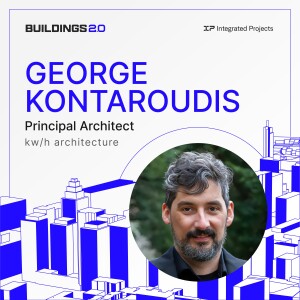
Thursday Aug 01, 2024
Thursday Aug 01, 2024
In this episode of Buildings 2.0, Jose speaks with George Kontaroudis, Principal Architect at kw/h architecture, to explore his journey from growing up in Greece to becoming a leader in sustainable architecture. George shares valuable insights on the critical role of sustainability in reducing global CO2 emissions, emphasizing the need for near-zero environmental impact designs, including becoming an advocate for passive house design.
He also dives into the transformative impact of AI on architectural workflows, explaining how it streamlines initial design phases while still requiring human oversight. Additionally, George highlights the importance of effective communication and humility in successful project collaborations.
Topics discussed:
How early mentorship and internships can shape a young architect's understanding and appreciation of design.
The importance of reducing CO2 emissions through sustainable design principles and creating buildings with near-zero environmental impact.
How AI is revolutionizing architectural workflows by streamlining initial design phases, such as massing studies, while still needing human oversight.
George's philosophy on using materials authentically and how this influences his design approach and project outcomes.
Strategies for maintaining clear and effective communication with contractors and clients to ensure successful project execution.
The value of humility and continuous learning when working with diverse teams on architectural projects.
How AI can provide multiple options for massing studies, saving time during the early design stages.
Approaching conversations with clients to discuss long-term benefits and sustainable design choices.
The evolving role of technology and AI in architecture and what young architects should consider for future success.
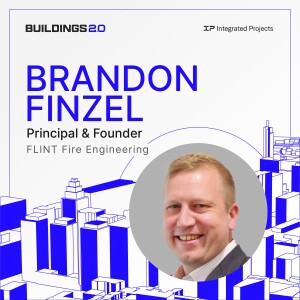
Thursday Jul 25, 2024
Thursday Jul 25, 2024
In this episode of Buildings 2.0, Jose speaks with Brandon Finzel, Principal & Founder at FLINT Fire Engineering. They explore the evolution of building codes and how cities like Boston are setting the standard for others to follow.
Brandon offers insights into the impact of technology on building management systems, highlighting how advanced tools can enhance efficiency and safety. He also gives his predictions for the future of commercial building experiences, offering a glimpse into the next decade of construction innovations.
Topics discussed:
How building codes have changed over the past few decades and the role of cities like Boston in setting new standards.
Insights into how advanced technology is being integrated into modern building management systems to enhance efficiency and safety.
Predictions on what the experience within commercial buildings will look like in the next decade, including emerging trends and innovations.
The importance of involving various disciplines early in the design process to address complex challenges in building projects.
How building resiliency tests are crucial to ensure that projects can withstand various stressors and maintain functionality.
Analysis of which sectors, such as commercial or institutional, show more urgency in adapting to the latest advancements in the field.
The necessity of creating detailed code compliance reports early in the project lifecycle to avoid issues during the design and construction phases.
The significance of understanding and precisely defining terms in building codes to ensure clarity and compliance.
How technology enables collaboration with experts worldwide, allowing them to contribute to projects regardless of their physical location.
The benefits of involving stakeholders, including designers and code consultants, at the initial stages of a project to set a clear direction.
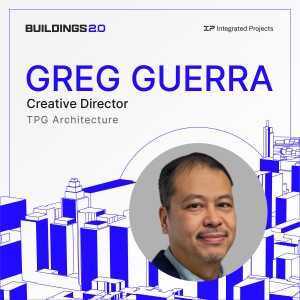
Thursday Jul 18, 2024
Thursday Jul 18, 2024
In this episode of Buildings 2.0, Jose speaks with Greg Guerra, Creative Director at TPG Architecture, to explore the evolving landscape of workplace design. Greg dives into the importance of balancing hybrid work with in-person collaboration, while ensuring that office spaces remain relevant and functional for years to come.
He also highlights the critical role of effective communication in translating client needs into innovative design solutions. Greg shares his thoughts on fostering creativity and encouraging young architects to voice their ideas as well as finding mentors to help guide and shape their careers.
Topics discussed:
The importance of translating client needs into compelling, understandable designs through model making and drawings.
The challenges and strategies for balancing remote work with in-person collaboration in the evolving workplace environment.
How to design office environments that remain functional and relevant for many years, adapting to changing needs and technologies.
The necessity of deeply understanding and listening to clients to create designs that truly meet their needs and aspirations.
The importance of younger team members speaking up and contributing their ideas during project meetings.
The rising focus on office amenities to attract employees back to physical workspaces and enhance overall workplace satisfaction.
The value of seeking out mentors and how mentorship can significantly impact an architect's career development and growth.
The benefits of in-person collaboration, particularly the speed and efficiency of idea generation and problem-solving during face-to-face interactions.

Thursday Jul 11, 2024
Thursday Jul 11, 2024
In this episode of Buildings 2.0, Jose speaks with Gary Ceder, Managing Director of Transaction Advisory at Cushman & Wakefield. Gary shares his journey from a marketing and advertising student to a leading commercial real estate broker. He shares his insights on the challenges commercial landlords face with class B or C buildings, particularly how they can make smart investments that will make their properties feel more welcoming without breaking their budgets.
Gary also offers strategic advice for startups transitioning from remote work to physical office spaces, and tips for young brokers on creating a competitive advantage in a commoditized industry.
Topics discussed:
How probing questions help brokers understand client needs and navigate complex real estate deals.
Unique challenges for landlords, especially with class B or C buildings, and how to address them.
Insightful advice for startups on determining the right time and approach to move from remote work to physical office spaces.
Tips on leveraging market know-how and technology to stand out in a commoditized brokerage industry.
The role of business development in the day-to-day activities of a commercial real estate broker.
Exploring options like fully enclosed suites with shared amenities for companies needing flexible office space arrangements.
The importance of in-person interactions for mentorship, coaching, and career advancement within the real estate industry.
How technology can provide competitive advantages and help brokers better serve their clients.
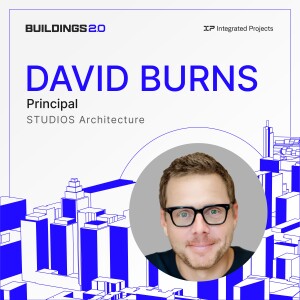
Thursday Jun 27, 2024
Thursday Jun 27, 2024
In this episode of Buildings 2.0, Jose speaks with David Burns, Principal at STUDIOS Architecture. David dives into the importance of diverse project types, from small renovations to large civic spaces, and how even small projects can significantly impact communities.
He shares insights on how AI and technology are revolutionizing the field, allowing architects to push creative boundaries and improve efficiency. David also discusses the evolving design of commercial office spaces in response to hybrid work models, emphasizing the need for flexible, amenity-rich environments.
Topics discussed:
The importance of working on a variety of project scales, from small renovations to large civic developments.
How AI and technology are transforming the architectural field, enhancing both creativity and efficiency in design processes.
The impact of hybrid work on commercial office design, emphasizing the need for flexible, amenity-rich environments that cater to various work preferences.
The similarities between educational and business projects and the importance of preparing students for real-world challenges.
The significance of maintaining ongoing dialogue with clients to explore different strategies and achieve the best outcomes for projects.
The benefits of sustainable design practices and how they can lead to better energy efficiency and economic results.
How architects should adapt to new market demands and evolving project types to stay relevant and innovative.
The changing expectations of young architecture graduates today compared to 20 years ago, focusing on work-life balance and career development.
Key questions commercial landlords should ask about their buildings to stay competitive, especially in bustling areas like Midtown Manhattan.
Reflections on how the future of architecture will be influenced by new tools, methods, and the integration of advanced technologies.
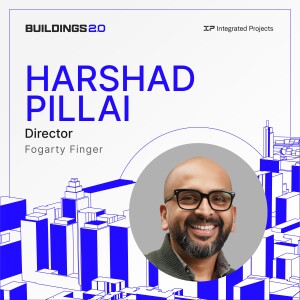
Thursday Jun 20, 2024
Thursday Jun 20, 2024
In this episode of Buildings 2.0, Jose speaks with Harshad Pillai, Director of Fogarty Finger. Harshad explores his journey from Mumbai to becoming a leader in urban architecture. He shares insights on defining successful architectural projects, emphasizing client satisfaction and alignment with design intent.
Harshad discusses the role of AI in the future of architecture and the importance of integrating sustainable practices into urban development. He also touches on the impact mentors have had on his career and why experienced architects should support newer professionals in the field.
Topics discussed:
Metrics for successful architectural projects, including client satisfaction and ensuring the built project aligns with the original design intent.
The impact of mentors on Harshad's career and the importance of supporting young professionals in the architecture field.
Integrating sustainable practices into urban development and moving beyond buzzwords to practical solutions.
How artificial intelligence is shaping the future of architectural design and the profession's adaptation to new technologies.
Balancing classicism, modernism, and formalism with a focus on performance and sustainability in architectural projects.
The benefits of cross-pollinating staff and leadership between housing and commercial markets in architectural practice.
Tips for young architects on navigating their career, focusing on continuous learning and prioritizing meaningful work.
Managing diverse aspects of architectural projects, from zoning laws and air rights to detailed construction elements like brick forcing and curtain walls.
Insights on what will remain constant in architecture despite macroeconomic challenges and rapid technological advancements.
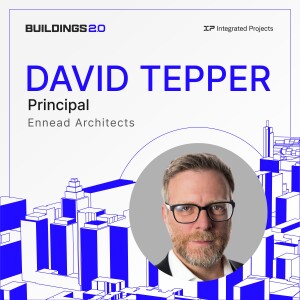
Thursday Jun 13, 2024
Thursday Jun 13, 2024
In this episode of Buildings 2.0, David Tepper, Principal at Ennead Architects, explores the evolving landscape of architecture in most of the typologies he has worked in. David shares his insights on fostering public interactions in physical spaces, highlighting the contrast with the digital world.
David also shares his insights into the challenges of retrofitting existing buildings to meet modern sustainability standards and discusses the profound impact of AI and other emerging technologies on the future of design and architectural training.
Topics discussed:
The importance of creating spaces that encourage public interactions and the unique challenges this presents in modern architecture.
The pressing need for sustainable building practices and the challenges of retrofitting existing structures to meet new standards.
How AI is transforming architectural design, from automating repetitive tasks to enhancing strategic project planning.
There’s a focus on how insights from different building typologies, like retail and healthcare, can inform and improve each other.
The evolving expectations of clients, particularly the demand for proven expertise and innovative solutions in architecture projects.
They discuss the impact of rising regulations on the architectural profession and how firms are adapting to these new challenges.
The future of architectural education, emphasizing the need for training that prepares students for technological advancements and sustainability challenges.
Insights on the future of urban planning, particularly how cities must adapt to changing environmental and technological landscapes.
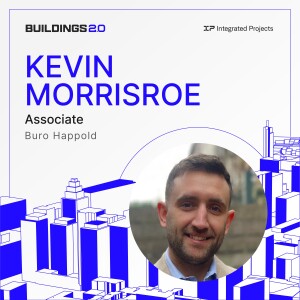
Thursday Jun 06, 2024
Thursday Jun 06, 2024
In this episode of Buildings 2.0, Kevin Morrisroe, Associate at Buro Happold, shares practical steps for landlords to transition their buildings to net-zero, highlighting the importance of prioritization and phased implementation for the highest return on investment.
Kevin also explains the impact of Local Law 97 in New York City and how city initiatives like it are driving change. Additionally, Kevin explores emerging trends and technologies that are reshaping the industry, offering valuable insights into creating smarter, more sustainable buildings. Kevin also touched on advancements in water reclamation and the potential role of AI in enhancing day-to-day tasks for engineers.
Topics discussed:
Practical steps and strategies for landlords to convert their properties to net-zero emissions, emphasizing phased approaches and prioritizing investments.
The impact of New York City's Local Law 97 on building emissions and how financial penalties are driving sustainability efforts in NYC and elsewhere.
New technologies and trends reshaping the industry, including smart building systems and water reclamation.
How implementing smart technologies can optimize energy use, improve efficiency, and provide better data for building management.
The growing importance of treating and reusing water within buildings to reduce demand and manage wastewater more effectively.
Identifying the highest ROI upgrades, such as replacing boilers and windows, to make buildings more energy-efficient.
Common objections to sustainable upgrades, primarily focused on upfront costs and the learning curve for new technologies.
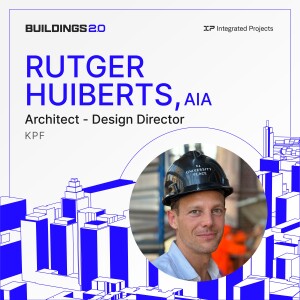
Thursday May 30, 2024
Thursday May 30, 2024
In this episode of Buildings 2.0, Rutger Huiberts, Design Director at KPF, shares his journey to leading innovative architectural projects worldwide, including the influence Japanese design principles have had on his own ideas and the value of beauty, art, and preservation in even the most data-driven processes.
Rutger also reflects on the importance of designing cities on a human scale and the integration of data-driven approaches in modern architecture. He discusses the practicalities of translating these philosophies into everyday work, from virtual meetings to on-site visits.
Topics discussed:
The importance of designing cities and buildings with a focus on human needs and uses, making spaces livable and interactive.
How technology and parametric design tools can create smarter, more artistic buildings that respond to human needs and environmental challenges.
Rutger and KPF’s commitment to sustainability, including the integration of green technologies and eco-friendly practices in architectural projects.
Navigating the complexities of working on projects across different time zones and continents, ensuring cohesive design and effective communication.
Inspiration from the modularity and adaptive reuse principles of the Japanese Metabolism movement, emphasizing flexibility and sustainability in design.
The increasing importance of using analytical tools to provide data-driven insights for improving building performance and sustainability.
How different local regulations impact architectural design and the importance of working with local experts to navigate these frameworks.
Trends in urban development, such as the integration of mixed-use spaces and the shift towards more livable, walkable cities.
The significance of maintaining face-to-face interactions and consistent involvement of team members throughout the design and construction process.


